
Like food and shelter, animals need play. When taking histories from clients during routine examinations or visits regarding their pets’ behavior problems, remember to ask clients whether they play with their pets.


Like food and shelter, animals need play. When taking histories from clients during routine examinations or visits regarding their pets’ behavior problems, remember to ask clients whether they play with their pets.

Cat owners can have a lot of questions: "Should I get a second cat as a playmate?" "How can I stop my cat from scratching the furniture?" "Why doesn't he use the litter box?" So in the spirit of David Letterman, I compiled this top 10 list of cat behavior tips.
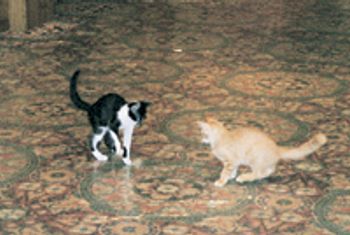
We must remember that interactions are a dance with roles for both partners, who each give and request information.
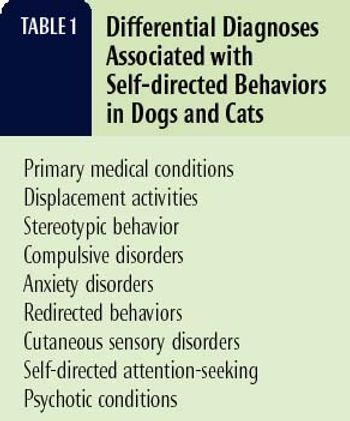
Although the prevalence of self-directed behaviors is not well-documented in dogs or cats, it is likely underappreciated because animals are not typically presented for evaluation of such behaviors unless the clients think their pets are manifesting a behavior problem or some degree of injury as a consequence of the behavior.

In the clinical research on human patient populations, the data suggest that the fastest way to induce and reinforce pathological panic is to remove any opportunity for self-control.

Body posture in dogs is an easy factor to assess in the signaling repertoire, but we too often ignore it. This quick tour through some common postures involving stance will help you understand what dogs are communicating and what their next movement might be.

So, for all the pets who suffer, here's the take home message: Storm and noise phobias are emergencies.

If a cat is housesoiling and the owner is finding large pools of urine in a discreet area or small amounts on vertical surfaces, the animal is not incontinent.
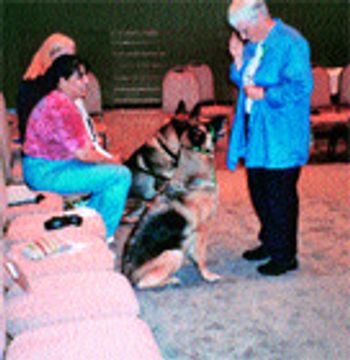
No signaling or communication system in social animals is simple. The main reason this is so involves context.

We've discovered a way to calm fractious cats while muzzling them.

As practitioners learn how important canine and feline social interactions and cognition are, they ask questions about how they can better understand the interactions and their outcomes. The key to understanding interaction is through signaling.

Last month, we discussed the history and treatment for Hoova, an 18-month-old female Shepherd mix, who was euthanized for her aggressive behaviors.

This is the story of two very different canine patients who met the same end: their people had them euthanized because of their behaviors.

Within a few months, Solo's separation anxiety had decreased and he could be left alone for an hour or so. As often happens with rescued dogs, he had also begun to show some other, less savory behaviors.

This column outlines the course of treatment for a dog who has been a patient for 2.5 years. It demonstrates the complexity of behavioral cases and as well as this client's understanding, tenacity and compassion. It also demonstrates the capacity of these distressed dogs to become more than we could ever have guessed.

This column illustrates the importance of addressing anxiety disorders as soon as they appear. Many people choose to "manage", rather than truly treat these conditions in the early stages because it is easier for the clients to live with some aspect of the problem under the new management regime.

Dr. Karen Overall helps pinpoint the cognitive changes dogs and cats experience as they grow older and offer insight in the challenges of diagnosing and managing such cases.

Last month (p. 20S) this column introduced the case of a 5-year-old rescued German Shepherd that became fearful.

This column deals with a fairly typical client concern, a rescued dog that becomes fearful. In the first of this two-part series, I will focus on the history and diagnosis. The second part will concentrate on treatment.
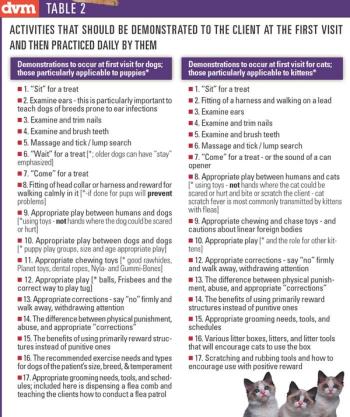
Dr. Karen Overall shows how to effectively use support staff to oversee behavior counseling within a practice.
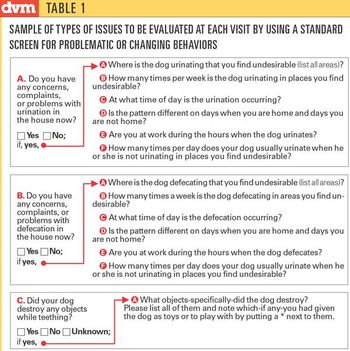
Dr. Karen Overall prepares practitioners to handle common behavior problems of pets so they can offer training advice to clients.

People who show and train dogs may know an awful lot more about dog behavior than does the average person; however, such exposure also may engender a specific form of "blinders".

Dogs within the same household can become violent with each other. In the case study explored this month, one dog is killed by another. The story of these dogs illustrates the classic interdog aggression scenario and all its misperceptions perfectly.

By working with your veterinarian, you can eliminate or even prevent many kitten behavior problems. Here are some common challenges and the steps your can take to lick 'em.

This column is courtesy of a former student who is now practicing in the Philadelphia suburbs and involves a 15-month old male, castrated Rhodesian Ridgeback who was returned to the breeder.